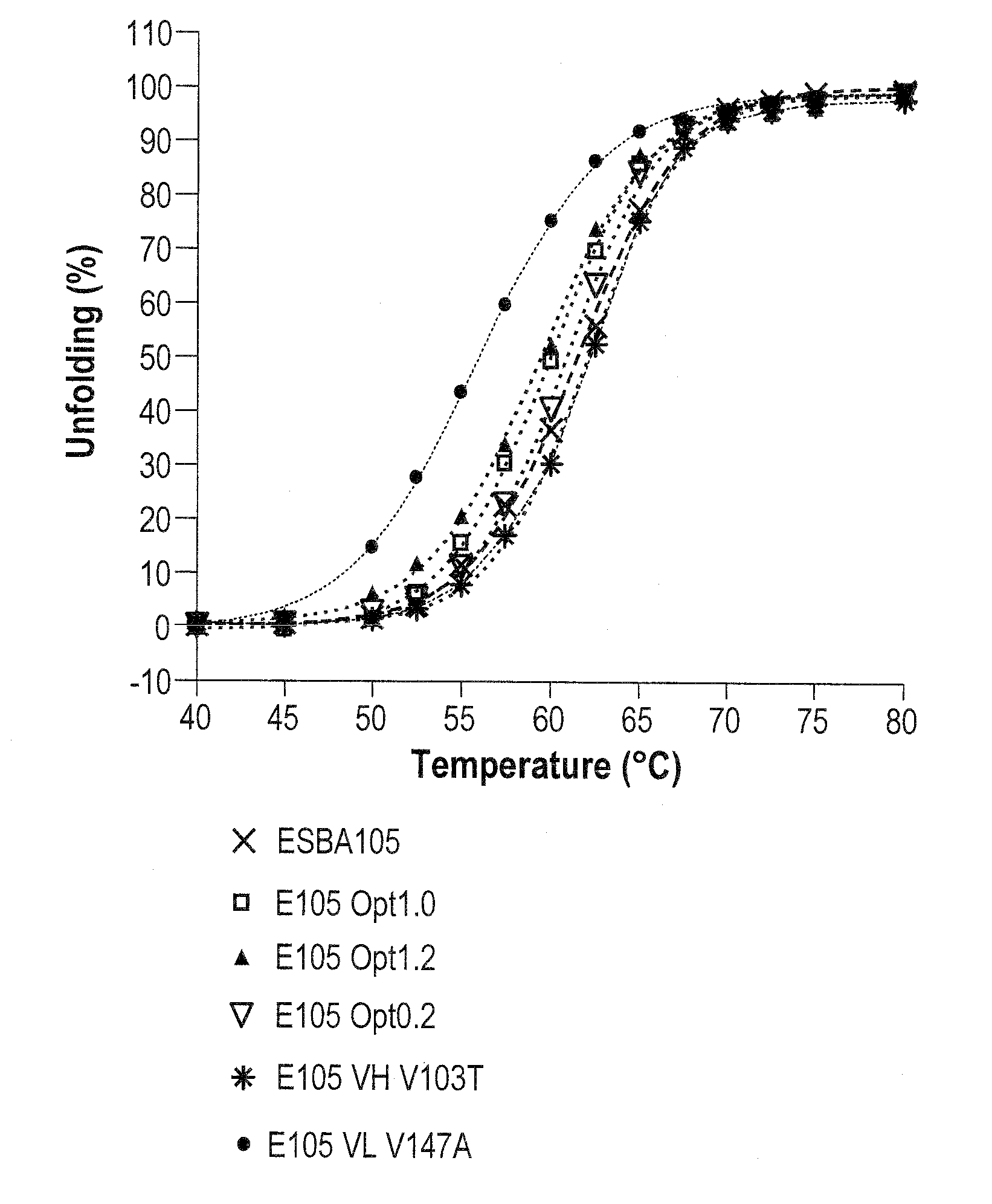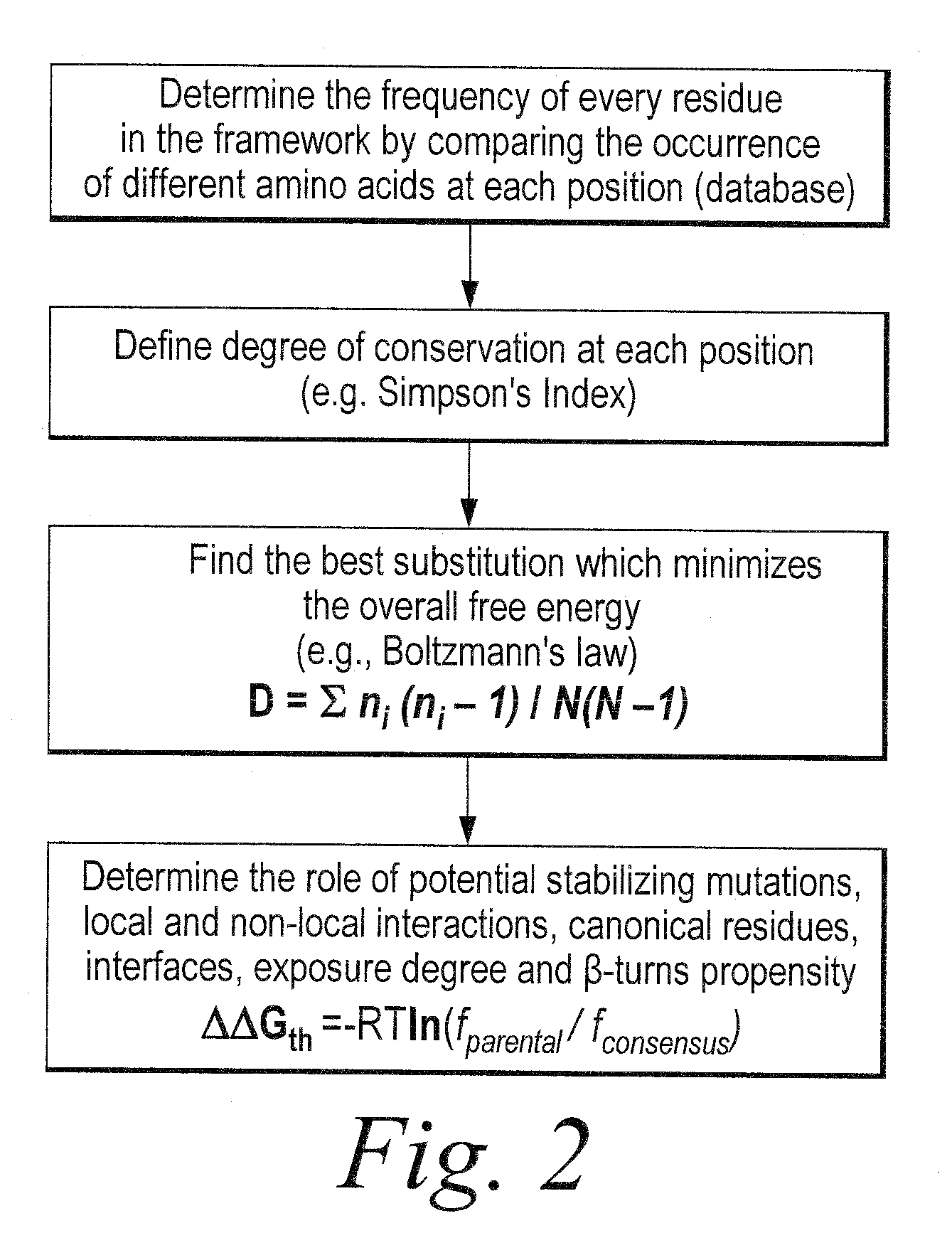Methods of modifying antibodies, and modified antibodies with improved functional properties
- Summary
- Abstract
- Description
- Claims
- Application Information
AI Technical Summary
Benefits of technology
Problems solved by technology
Method used
Image
Examples
example 1
Antibody Position Numbering Systems
[0535]In this example, conversion tables are provided for two different numbering systems used to identify amino acid residue positions in antibody heavy and light chain variable regions. The Kabat numbering system is described further in Kabat et al. (Kabat, E. A., et al. (1991) Sequences of Proteins of Immunological Interest, Fifth Edition, U.S. Department of Health and Human Services, NIH Publication No. 91-3242). The AHo numbering system is described further in Honegger, A. and Pluckthun, A. (2001) J. Mol. Biol. 309:657-670).
Heavy Chain Variable Region Numbering
[0536]
TABLE 1Conversion table for the residue positions in the Heavy ChainVariable DomainKabatAHoKabatAHoKabatAHo 11445187101 22455288102 33465389103 44475490104 55485591105 66495692106 77505793107*8515894108 89525995109 910 52a60961101011 52b61971111112 52c62981121213*639911313145364100 11414155465100a11515165566100b11616175667100c11717185768100d11818195869100e11919205970100f12020216071...
example 2
Sequence-Based Analysis of scFv Sequences
[0538]In this example, the sequence-based analysis of scFv sequences is described in detail. A flowchart summarizing the process of the analysis is shown in FIG. 1.
Collection and Alignment of Human Immunoglobulin Sequences
[0539]Sequences of variable domains of human mature antibodies and germlines were collected from different databases and entered into a customized database as one letter code amino acid sequences. The antibody sequences were aligned using an EXCEL implementation of the Needleman-Wunsch sequence alignment algorithm (Needleman et al., J Mol Biol., 48(3):443-53 (1970)). The database was then sub-divided into four different arrays (according to the original data source) to facilitate the subsequent analysis and comparison, as follows:[0540]VBase: Human germline sequences[0541]IMGT: Human germline sequences[0542]KDB database: Mature antibodies[0543]QC database: Selected scFv frameworks selected by Quality Control screening
The QC ...
example 3
Identification of Variability-Tolerant and Unusual Residue Positions
[0550]Using the sequence-based scFv analysis approach described above in Example 2, three heavy chain variable region families (VH3, VH1a and VH1b) and three light chain variable region families (Vκ1, Vκ3 and Vλ1) were analyzed to identify variability-tolerant amino acid positions. In particular, the degree of diversity, as calculated using the Simpson's Index, was determined for each amino acid position for sequences within four different databases, Vbase, IMGT, KDB and QC (selected scFvs), as described above. Variant-tolerant and unusual residue amino acid positions were identified based on differences in the Simpson's Index values at those positions for the Vbase and IMGT germline databases as compared to the QC selected scFv database. Additionally, for the identified positions of interest, the germline consensus residue was identified and the frequency of that consensus residue in the QC and KDB databases was de...
PUM
 Login to View More
Login to View More Abstract
Description
Claims
Application Information
 Login to View More
Login to View More - R&D
- Intellectual Property
- Life Sciences
- Materials
- Tech Scout
- Unparalleled Data Quality
- Higher Quality Content
- 60% Fewer Hallucinations
Browse by: Latest US Patents, China's latest patents, Technical Efficacy Thesaurus, Application Domain, Technology Topic, Popular Technical Reports.
© 2025 PatSnap. All rights reserved.Legal|Privacy policy|Modern Slavery Act Transparency Statement|Sitemap|About US| Contact US: help@patsnap.com



